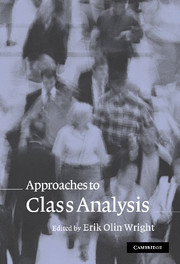Book contents
- Frontmatter
- Contents
- List of figures
- List of tables
- List of contributors
- Introduction
- 1 Foundations of a neo-Marxist class analysis
- 2 Foundations of a neo-Weberian class analysis
- 3 Foundations of a neo-Durkheimian class analysis
- 4 Foundations of Pierre Bourdieu's class analysis
- 5 Foundations of a rent-based class analysis
- 6 Foundations of a post-class analysis
- Conclusion: If “class” is the answer, what is the question?
- References
- Index
Conclusion: If “class” is the answer, what is the question?
Published online by Cambridge University Press: 22 September 2009
- Frontmatter
- Contents
- List of figures
- List of tables
- List of contributors
- Introduction
- 1 Foundations of a neo-Marxist class analysis
- 2 Foundations of a neo-Weberian class analysis
- 3 Foundations of a neo-Durkheimian class analysis
- 4 Foundations of Pierre Bourdieu's class analysis
- 5 Foundations of a rent-based class analysis
- 6 Foundations of a post-class analysis
- Conclusion: If “class” is the answer, what is the question?
- References
- Index
Summary
The specific definitions and elaborations of the concept of class that have been explored in this book are shaped by the diverse kinds of questions class is thought to answer. A concept whose task is to help answer a question about broad historical variations in the social organization of inequality is likely to be defined quite differently from a concept used to answer a relatively narrow question about the subjective identity of individuals in contemporary society. These questions, in turn, are embedded in broad theoretical frameworks. This is one of the things which theoretical frameworks do: they help pose questions. Questions are not generated simply by curiosity and imagination encountering the empirical world; they are generated by curiosity and imagination, organized by theoretical assumptions and animated by normative concerns, encountering the empirical world. These assumptions and concerns are what give specific questions salience and demarcate the tasks that the concept of class is called upon to accomplish. One way of trying to sort out the various perspectives on class explored in this book is thus to map them onto the salient inventory questions posed within class analysis. This will be the task of this chapter.
Six questions are particularly important for which the word “class” often figures centrally in the answers:
Distributional location: “How are people objectively located in distributions of material inequality?”
Subjectively salient groups: “What explains how people, individually and collectively, subjectively locate themselves and others within a structure of inequality?”
Information
- Type
- Chapter
- Information
- Approaches to Class Analysis , pp. 180 - 192Publisher: Cambridge University PressPrint publication year: 2005
Accessibility standard: Unknown
Why this information is here
This section outlines the accessibility features of this content - including support for screen readers, full keyboard navigation and high-contrast display options. This may not be relevant for you.Accessibility Information
- 18
- Cited by
